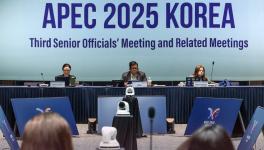Trump's Decision to Leave the TPP Was to Protect One Faction of the Super Rich

US Trans Pacific Partnership
U.S. President Donald Trump decided that the United States would now exit from the trade negotiations known as the Trans-Pacific Partnership. Embarrassingly, some U.S. labor leaders stood beside him to celebrate this action. Is the U.S. withdrawal from the TPP part of a plan to encourage employment in the United States? No. The exit of the United States from the TPP should be understood along two axis – one merely about U.S. politics and the other about a new strategy to revive flagging U.S. power in the world.
If Trump were serious about an exit from "globalization" he would have simultaneously made noises about a host of other trade deals – Trade in Services Agreement (TISA) and the U.S.-China Bilateral Investment Treaty. But he did not. Nor did he fire the 500 U.S. trade advisers, who, as Lori Wallach of Public Citizenwrote, represent corporate interests in the framing of such trade agreements. He does not want to rock the globalization boat. That is not his real interest.
It is not China or Mexico (as Trump puts it) nor corporate greed (as the unions sometimes say) that has hit the U.S. workforce hard. What has dented this workforce is the logic of capitalism, the drive by firms in competition with each other for lower wages and for machines to replace humans. The false trade wars and threats of force as well as sanctions are no answer to the dynamic that displaces humans on behalf of profit. The only answer on offer from the establishment, including Trump, is demagogy. The endemic jobs crisis deserves serious solutions: social control over the surplus to improve the quality of people’s lives, a shorter workday, better social services, and richer cultural lives. None of this is part of our conversation.
False Hope
Trump cleverly ran an election campaign against both the TPP and the North American Free Trade Agreement. He made the case that it is because of trade deals such as TPP and NAFTA that jobs in the United States have disappeared, producing the "American carnage" he talked about in his inaugural address. If these deals would be torn up, he said, it would somehow "Make America Great Again."
Trump argued that these kinds of deals helped China and Mexico and hurt America. This is a deception. Actually, these trade deals hurt Chinese, Mexican and American workers and advantage global capital. It is global capital that benefits from the current globalization regime.
Getting out of these deals—like "keeping" the Carrier plant in Indiana—makes for excellent news, particularly when the media fails to educate the public about the nature of the withdrawal from the TPP and the call to renegotiate NAFTA.
Why have jobs disappeared, not only in the United States or the West, but also, according to the International Labour Organization, worldwide? Two processes have debilitated the world’s workforce, and both to the advantage of global capitalism:
-
Global Labor Arbitrage, namely taking advantage of the massive wage differentials when the IMF forced countries of the Third World to make their workers available to global capitalism after the 1980s debt crisis. The addition of Chinese labor and labor from the former USSR and Eastern Europe by the early 1990s was also a death knell for the more expensive Western workforce. Specifically for the US workforce, social benefits withered in this period as the rich went on strike and refused to pay taxes to fund these programs. Workers now have to bear many social costs (education, health care, pensions), which they had partially enjoyed through unions and through social democratic policies. Without social subsidies, the US workers are far more expensive than workers elsewhere. In this context, investment firms such as Goldman Sachs and Morgan Stanley drove an agenda of asset stripping, tearing down industrial plants in the US and selling them to other countries, while allowing towns and rural areas to rust into the despair of opioids and other social maladies. There is no incentive for global capitalism – even with the destruction of environmental and labor regulations by Trump – to re-enter the US economy in a substantial way. Obama’s fiscal policy delivered cheap capital to banks, which sat on these assets and did not make sufficient productive investments from them. There was no incentive to do so in a way that would hire those ‘forgotten Americans’ that Trump campaigned on behalf. Trump’s theatrics about a ‘border tax’ will mean nothing. Such measures will be squashed or diluted by his own cabinet, particularly by the Commerce Secretary Wilbur Ross (the King of Bankruptcy) and the Treasury Secretary Steve Mnuchin (Goldman Sachs).
-
Robotics. The economist John Maynard Keynes wrote of ‘technological unemployment’, where machines replace human workers and leave them redundant. This process was visible to Karl Marx in the 19th century, who suggested that the logic of capitalist accumulation would turn towards the substitution of humans by machines. This is precisely what has already occurred in several key high-tech sectors, not only in the manufacture of automobiles but also in the making of computers. The US, since 1979, has lost over seven million factory jobs and yet, factory production has doubled in this period. Michael Hicks and Srikant Devaraj at the Center for Business and Economic Research show that 88 percent of job loss in the US ‘can be attributable to productivity growth, and the long-term changes to manufacturing employment,’ namely mechanization. Neither Mexico nor China is the culprit. The blame has to be placed squarely on a system – capitalism – that seeks to displace human workers for machines. This process is unstoppable. A McKinsey Global Institute study finds that more than half of the activities in the US economy in manufacturing, accommodation, food service and the retail trade could be automated at current rates of technology. These changes, say the McKinsey analysts, ‘will not happen overnight.’ But they will happen. Already in banks and airports as well as in fast food outlets, machines dispense money, check you in and help you order – this is the fate of the service sector.
None of these social conditions would be a surprise to young people. The 2016 International Labour Organization report on youth unemployment shows how young people are not only overrepresented among the unemployed but they are overrepresented among the involuntary temporary and part-time workforce. This condemns young people to extreme poverty and to migration. Trump will demonize migrants, but not consider the causes of migration, which is the same as the cause of the "American carnage."
None of this will be addressed by Trump or the Democrats or the political class in the West. They will not talk about this nor will they do anything to ameliorate the condition of the working people. Slogans such as a Four Hour Day or Fairer Distribution of the Productivity Gains or More Social Wages (free health care, free education, free public transportation) are simply not in the cards. These would be a rational response to the ongoing social crisis in the world. But they are irrational ideas for the capitalist system.
Encircle Eurasia
The Trans-Pacific Partnership of 12 nations that rim the Pacific Ocean had little to do with trade. Most of these countries have close economic ties with each other and have very liberal trade relationships. The main push for the TPP was to isolate China. On 5 October 2015, former US President Barack Obama caviled at criticism of the TPP, saying ‘We can’t let countries like China write the rules of the global economy.’ This was the essence. US military bases from Japan to Australia as well as the TPP were intended to send a message to Beijing: accept the US-driven rules or else be pushed out of crucial markets in South-East and East Asia. These are mafia-tactics to protect the hegemony of the United States.

At the same time, in Europe, the Obama administration pushed the Transatlantic Trade and Investment Partnership (TTIP). In WirschaftsWoche (November 17, 2016), Obama and German Chancellor Angela Merkel wrote that Germany and the US should jointly ‘shape globalization based on our values and our ideas.’ Who should not shape the rules of globalization? Not Greece and other southern European countries, surely, and not – of course – Russia. NATO’s expansion into Eastern Europe – to the Russian border in Poland – is the cognate of US bases in Okinawa and Subic Bay against China. The TTIP, like the TPP, sought to ensure that European countries would not entangle themselves with the emerging Russian power. The Russians called the TTIP an ‘economic NATO.’ Trump’s White House has removed the page on TTIP from its website. This is close enough to an annulment as possible.

Photo Credit: Puck Magazine
These are less trade regimes and more weapons to isolate China and Russia at the two ends of Eurasia. In 2010, Russian President Vladimir Putin spoke of a trade alliance that would run from ‘Vladivostok to Lisbon.’ This was unacceptable to the Europeans and the United States. The Russians had developed their own trade regime – the Eurasian Economic Union – and the Chinese have their own – the Regional Comprehensive Economic Partnership. These blocs have also been cooperating with each other through the Chinese Silk Road Project and toward the development of Russian-Chinese economic integration. The more that the West has tried to cut Russia and China off from its markets, the more they have found conjoint interests between each other. It is unlikely that the Trump administration will be able to drive a wedge between Beijing and Moscow.
Trump might have softened the US government’s language on Russia, but he has not done so regarding China. The withdrawal from the TPP will not change the essential strategic drive of that policy – to isolate and threaten China. ‘Peace through strength’ is Trump’s framework for US belligerence against China. This is a project that is identical to Obama’s pivot to Asia. At Davos, the Chinese premier Xi Jinping said pointedly that a trade war would not benefit anyone. This is not entirely true. Only four percent of Chinese manufacturing comes to the United States. Tariffs here would not be devastating to Chinese business interests. A 45 percent tariff on Chinese imports will destroy the standard of living for American consumers – many of whom have languished with stagnant wages. Retaliation from China might weaken the power of banks to offer credit lines to an increasingly indebted US workforce. A trade war – or even a war – between China and the United States, if it hurts anyone, will hit the US working class very hard. This is something that Trump has not mentioned to his constituency. His is an incoherent populism – pushing what appears to be a critique of globalization at the same time as he carries forward those same policies.
Vijay Prashad is professor of international studies at Trinity College in Hartford, Connecticut. He is the author of 18 books, including Arab Spring, Libyan Winter(AK Press, 2012), The Poorer Nations: A Possible History of the Global South(Verso, 2013) and The Death of a Nation and the Future of the Arab Revolution(University of California Press, 2016). His columns appear at AlterNet every Wednesday.
Disclaimer: The views expressed here are the author's personal views, and do not necessarily represent the views of Newsclick
Get the latest reports & analysis with people's perspective on Protests, movements & deep analytical videos, discussions of the current affairs in your Telegram app. Subscribe to NewsClick's Telegram channel & get Real-Time updates on stories, as they get published on our website.
























